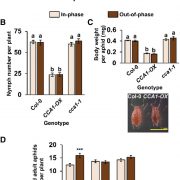
Circadian Clock Gene Affects Aphid Feeding
Plant Physiology, Plant Physiology: On The InsidePhloem sap-feeding aphids inflict plant damage by direct feeding and by acting as a vector for plant disease transmission. Their highly specialized stylets reach the phloem sieve elements, allowing aphids to extract plant photoassimilates without consuming structural tissues. Probing and feeding by aphids…

Improving Grain Filling Rate in Rice
Plant Physiology, Plant Physiology: On The InsidePoor grain filling by hybrid japonica rice (Oryza sativa) is a major agricultural problem. It has previously been reported that the rice accession Ludao, a wild-type japonica rice grown naturally in the Liangyungang region of China, exhibited a high grain-filling rate and could be selected as a parent…
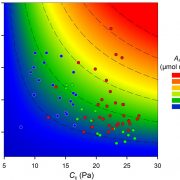
CO2 and O2 as Drivers of Plant Macroevolution
Plant Physiology, Plant Physiology: On The InsideThe evolution of photosynthesis and, at a later point, the emergence of land plants resulted in substantial changes in the composition of Earth’s atmosphere. Plant colonization of the land in the early Paleozoic (more than 450 million years ago [mya]) was followed by a rapid drop in atmospheric [CO2],…
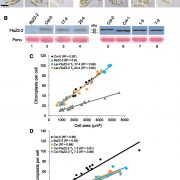
A Gene Affecting Chloroplast Size
Plant Physiology, Plant Physiology: On The InsideDuring leaf growth and development, chloroplast numbers increase to maximize photosynthetic capacity. In mesophyll cells, chloroplast division takes place primarily during cell expansion and increases plastid numbers from; 10 to 20 in leaf primordia to; 100 or more in mature mesophyll cells. Chloroplasts…

Acylsugar Metabolic Gene Network
Research, The Plant Cell, The Plant Cell: In a NutshellBy Sabyasachi Mandal
Department of Biology, Texas A&M University, College Station, USA
Background: Acylsugars are specialized metabolites secreted through the trichomes (plant hairs) of many plants in the nightshade family (Solanaceae). These compounds provide protection against herbivores…
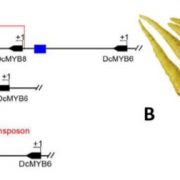
Purple is the New Orange: Anthocyanin Regulation Coming Together in Carrot
Plant Physiology, Plant Physiology: News and Views, ResearchWestern cultivated carrot (Daucus carota subsp. sativus L) is broadly known for its orange pigmentation and accumulation of carotenoids, known as the carotene group (var. sativus). However, the eastern wild carrot (subsp. carota) originating from southwestern Asia over a century ago provides purple pigmentation…
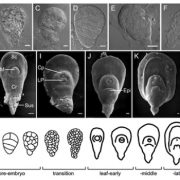
Transcriptome Dynamics and Gene Activities during Embryo and Grain Development in Wheat
Research, The Plant Cell, The Plant Cell: In a NutshellXiang et al. elucidate transcriptome dynamics and gene activities during embryogenesis and grain development in modern wheat and its progenitors. Plant Cell https://doi.org/10.1105/tpc.19.00397.
By Daoquan Xiang, Teagen D. Quilichini, Peng Gao, and Raju Datla
Aquatic and Crop Resource Development,…

Recognizing Plant Physiology authors: Minoru Ueda
Plant Physiology, Plant Physiology: Author ProfilesMinoru Ueda, first author of Histone modifications form epigenetic regulatory networks to regulate abiotic stress response
Current Position: Researcher
Education: B.A. in Genetic Engineering, faculty of Agriculture, Hokkaido University, and Ph.D. in Plant Molecular Genetics, Graduate School of Agricultural…

Recognizing Plant Cell authors: Ken-Der Wang
The Plant Cell, The Plant Cell: Author ProfilesKen-Der Wang, first author of OXYLIPINS OTHER THAN JASMONIC ACID ARE XYLEM-RESIDENT SIGNALS REGULATING SYSTEMIC RESISTANCE INDUCED BY TRICHODERMA VIRENS IN MAIZE
Current Position: Postdoctoral Research Associate in Dr. Charles Kenerley’s lab, at Texas A&M University
Education: PhD in Plant…

